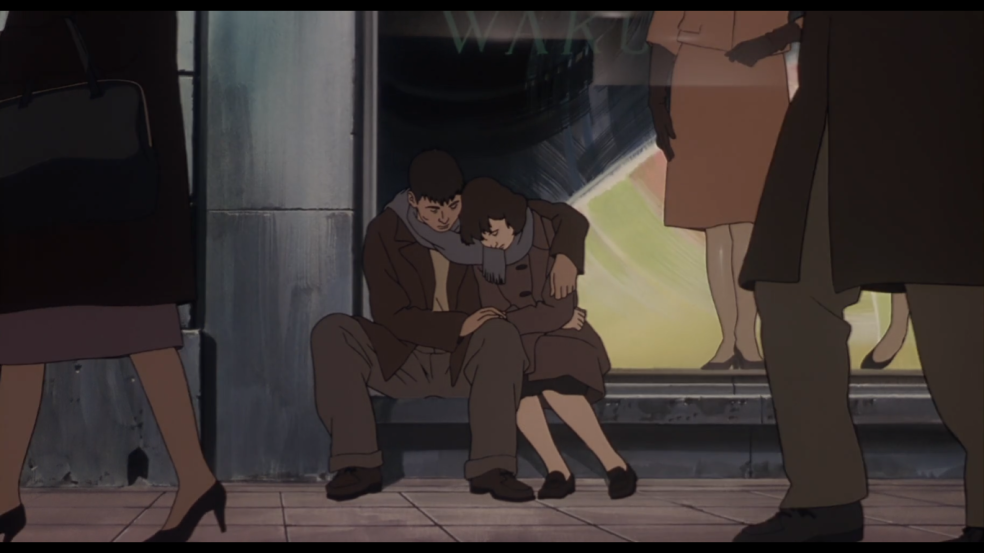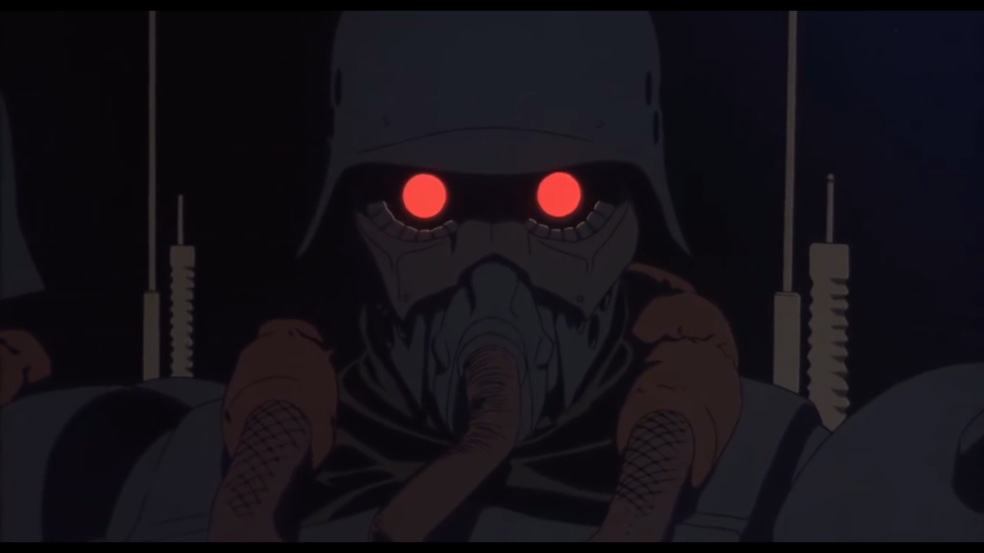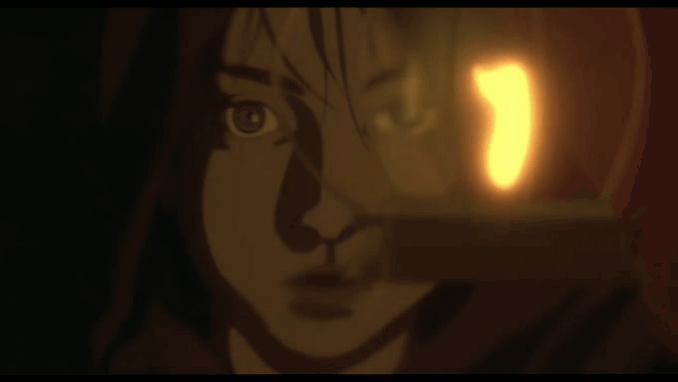Ages ago, I wrote a review of Jin-Roh the Wolf Brigade. Looking back, it’s a very pretty piece that’s useless as a review or recommendation of the movie, and it’s structurally clumsy. if anything though, it manages to convey my conflicted feelings on the movie at the time. The plot of Jin-Roh is both simple and complicated and several nuances were lost in my attempt to understand what was going on between the cryptic political drama and the metaphorical allusions to Little Red Riding Hood. Re-watching the film for a third time, this time subbed (so I could grasp what was being said), really elevated my appreciation of the film. These ideas have been stewing in my brain for a while now, so here’s a written piece exploring them. Needless to say, there will be spoilers. Watch the film, it’s fantastic.
Objective vs Subjective Perspective
Hiroyuki Okiura is an excellent director because of how spartan he is. There are few ‘flourishes’ within the film, just a very strict dedication to realistic movement, realistic camerawork and realistic story-boarding. The characters don’t just move in a very restrained manner, they act in a restrained manner. It’s common in anime to hold a pose for a long as possible, but in Jin-Roh, it feels like a conscious decision- both to mimic the way people physically communicate in conversation, but also to highlight the emotional emptiness of the film. Our titular character, Fuse, is emotionally stymied, and the world he inhabits is similarly cold and detached, teeming with ruthless politicians and schemers. If a recurring theme of the story is the sacrifice of one’s humanity in order to uphold the status quo, then it’s fitting that the direction will reflect this lack of human warmth.

When I described Okiura’s directing as spartan, perhaps the better word to use would have been objective. In the opening scene of Jin-Roh, the world is presented from an impartial perspective, with multiple characters playing different roles in the initial conflict. There’s no attempt to portray any particular group as more heroic than the other- the conflict simply is, and escalates due to the actions of many individuals. However, the revolving perspectives give insight into these characters’ psyche- they allow the audience to observe the way their emotions fluctuate as the situation goes radically out of hand. One character who makes a lasting impression is the ‘red riding hood’, a young woman who acts as a bomb courier for the anti-government radicals and who blows herself up when caught by government forces. Whilst the directing is objective, there is something genuinely fascinating about watching the girl’s confidence crumble as she finds herself cornered on all sides in one of the most intense scenes in the film. At the apex of the scene, Okiura drops the objective camerawork to create this image:

Suddenly, the audience sees the Special Unit as the girl sees them. The extreme close-up and the sudden emission of sound heighten the eeriness and the terror of their design. This image is recurrent and acts as a premonition- the characters on the other side of that gaze act out in fear and pay the consequences. The young girl, for instance, blows herself up. However, the film’s dedication to her perspective segues excellently into Fuse’s side of the story- her death triggers something in his humanity that will later be exploited by virtually every other character in the film.
A Literary Parallel to Villette
The main literary allusion in Jin-Roh is to Little Red Riding Hood, and the movie’s themes and visual design revolve around that allusion. However, I found that Fuse shared several similarities to the heroine of Charlotte Bronte’s final novel, Villette. Lucy Snowe is a woman whose major problem is that she buries a wildly passionate personality underneath a cold and passive facade. She’s often successful, maybe a little too successful and a lot of the novel is these two halves of her character fighting each other. Her cold and rational side, she names ‘Reason’ and her passionate side, she names ‘Imagination’. Lucy attempts to suffocate Imagination using Reason, mentally suffers from suffocating Imagination, wishes relief from mental suffering, wishes to express Imagination and is resentful of Reason, but then decides that to be cold and rational is most sensible, and goes back to repressing Imagination. Fuse is not quite as detailed in his dilemma as Lucy Snowe, but the same idea remains- an uncomfortably flawed human interior clawing beneath a stoic, passive exterior. Charlotte Bronte writes from the first-person perspective, which as a film, Jin-Roh can’t do, so it’s interesting to observe how both creators allude to the inner passion of both characters. Bronte, true to her Gothic roots, goes on these wild deviations from the plot as Lucy lapses into long bursts of emotional, metaphorical language that obsessively detail the burden she bears. Okiura, the realist filmmaker operating in the third person, hints at Fuse’s humanity. In one scene, he observes the people on his tram with exacting intensity and his body language, as he is physically isolated on that tram, is deeply melancholic.

Fuse’s sadness contrasts the vitality of the lives that exist beyond him, outside the political scheming he’s embroiled in. Kei Amemiya, the second girl he meets, exists in this world that he desires to be a part of, but can’t because of his loyalties. It’s easy to lose the subtleties of their relationship due to Fuse’s stoicism, but this is where perspective and the animation combine. Fuse never vocalises his love for Kei, but the way she acts when the camera switches to his subjective viewpoint speak louder than words. Kei delicately tucks wind-swept hair behind her ears, she runs her fingers along the concrete walls of the bridge, she smiles beautifully at Fuse, and she speaks gently to him. These flourishes of detail mark Rei uniquely from the economical animation of the government characters, and convey this sense that she is special to Fuse- because she represents the humanity that he secretly desires.

But to any Lucy Snowe character, good things are troubling and disconcerting, given their tendency for self-flagellation- and Fuse’s affection for Kei start to run concurrent with the reality of his situation. In one scene, he relives elements of the suicide bombing, but this time the girl’s face is replaced with Kei. And like Lucy Snowe, he has his own wild Gothic moment where all passion broiling under the surface explodes and becomes startlingly apparent. The dream sequence in the middle of the movie seems to be everything: foreshadowing, character moment, metaphor, exposition. Fuse is expressive in his character animation, displaying such blatant emotion that it comes across as jarring. The scene condenses the core conflict of Fuse’s character- his loyalty to his ‘pack’ in the Special Unit versus his love and desire for Kei. The scene’s violence is commingled with the most overt sexualisation of Kei in the film, and when Fuse imagines her death, it’s as beatific as it is graphic. This, to me, is the clearest declaration of love we can get from a character like Fuse. It’s perverse that a scene so violent has to represent love, but it’s really the only way, in my opinion. The violence compounds the strength of Fuse’s feelings, and besides, his world is violent, and he is a man constantly fighting a battle with his own humanity.
Kei

I like the composition and animation of this shot a lot, but I like the story being told behind it a lot more. This is the only time we see Kei in her private space, without Fuse’s perspective serving as our only knowledge of her. This reveal into her personal life also draws Kei away from the idealisation that we see from Fuse and further into the reality of the politics that surround this character. I think the most tragic part of Kei’s character is how little agency she has. We never see Kei’s perspective of herself or of her relationship with Fuse until later in the movie. And the reality is very different- a lot more sombre, a lot more cynical, sharing Fuse’s sadness. The scene where she confides to Fuse that at some point she got tired of thinking, and accepted and did whatever was wanted of her drives their similarities home. The line, ‘when I see the same sadness in you, I start to dream’ is where the tears really start, because that sadness that binds her and Fuse is so palpable. And the concept of two lonely people finding solace in their shared isolation is depressing. Kei’s ultimate powerlessness in outcome of the relationship adds to her tragedy as a character- her perspective is ultimately meaningless, even to the man who loves her.

In the end, Fuse cannot escape the parallels to Lucy Snowe. In Villette, Lucy loses her fiancee in a storm- the storm, her world’s greater force, being the recurrent symbol for the loss of her family. Similarly, Fuse’s loyalty to his pack – the greater force of his world- is stronger than his love for Kei, and he kills her. Fuse’s humanity dies with Kei – Reason crushes Imagination.
So, as you might guess, I cried lots of ugly tears over this film and it’s now a favourite. To the point where I returned to this blog for it…yeah, this blog kind of died for a long while, which was not my intention at all. I have nearly 13 half-written drafts staring at me in the face, which I abandoned because they just didn’t ‘feel right’ or something. Which was exactly what I vowed not do in my last post, so I’m very embarrassed and so, so sorry. My tendencies turned out to be very hard to break, and I also made those promises right before exam season, like a fool. I still can’t promise regular updates from now on, because exam season looms yet again and I really should be revising (last year of secondary school whoo!) – but this film has been eating away at me for the past 2 months and I wanted to make up for that old review. I’m happy with the result, and I hope you enjoyed it too!



